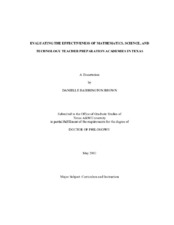| dc.contributor.advisor | Waxman, Hersh | |
| dc.contributor.advisor | Scott, Timothy | |
| dc.creator | Brown, Danielle Bairrington | |
| dc.date.accessioned | 2012-07-16T15:56:59Z | |
| dc.date.accessioned | 2012-07-16T20:32:27Z | |
| dc.date.available | 2012-07-16T15:56:59Z | |
| dc.date.available | 2012-07-16T20:32:27Z | |
| dc.date.created | 2011-05 | |
| dc.date.issued | 2012-07-16 | |
| dc.date.submitted | May 2011 | |
| dc.identifier.uri | https://hdl.handle.net/1969.1/ETD-TAMU-2011-05-9311 | |
| dc.description.abstract | The purpose of this mixed-methods study was to evaluate the effectiveness of 14
Mathematics, Science, Technology Teacher Preparation (MSTTP) Academies located
across the state of Texas. The aim of the academies was to increase the number of highly
qualified mathematics, science, and technology teachers, while also improving the
quality of certified teachers in these areas by focusing on seven established goals. The
researcher examined best practices for professional development and teacher preparation
utilized by the academies, as well as strengths and weaknesses. Additionally, the extent
to which the participants perceived the academy had improved their content knowledge
and pedagogical skills was examined. Finally, the extent to which the seven goals were
associated with participants’ perceived content knowledge and pedagogical knowledge
was analyzed. The study used secondary data from a larger evaluation of the MSTTP
Academies. A mixed-methods design utilizing triangulation to analyze both quantitative
and qualitative data was employed for the study.
The results of the current study revealed that the14 MSTTP academies
demonstrated the following key strengths: (a) a focus on strengthening content
knowledge; (b) a willingness for developing professionally committed teachers; and (c)
providing funding for participants. In regard to weaknesses, the degree of program
effectiveness revealed that none of the academies had fully implemented all seven goals.
All 14 academies, however, struggled to accomplish two of the goals: (a) the integration
of the areas of science technology and mathematics; and (b) the infusion of technology
into curriculum. Additionally, the findings indicate that participants felt as though the
academies had improved their content knowledge and pedagogical skills. The findings
also reveal that all academies exhibited three features of effective professional
development: (a) a focus on content; (b) active learning opportunities; and (c) intensive
and sustained over time. Only one academy exhibited the remaining two features,
collective participation and coherence. Finally, the study revealed that only the goal of
strengthening content knowledge was a good predictor for participants’ content
qualifications, while strengthening content knowledge and strengthening pedagogical
skills were good predictors of participants’ pedagogical qualifications. This research
study contributes to the to fields of teacher preparation and professional development. | en |
| dc.format.mimetype | application/pdf | |
| dc.language.iso | en_US | |
| dc.subject | Teacher Preparation | en |
| dc.subject | STEM Education | en |
| dc.title | Evaluating the Effectiveness of Mathematics, Science, and Technology Teacher Preparation Academies in Texas | en |
| dc.type | Thesis | en |
| thesis.degree.department | Teaching, Learning, and Culture | en |
| thesis.degree.discipline | Curriculum and Instruction | en |
| thesis.degree.grantor | Texas A&M University | en |
| thesis.degree.name | Doctor of Philosophy | en |
| thesis.degree.level | Doctoral | en |
| dc.contributor.committeeMember | Kelly, Larry | |
| dc.contributor.committeeMember | Stuessy, Carol | |
| dc.type.genre | thesis | en |
| dc.type.material | text | en |


